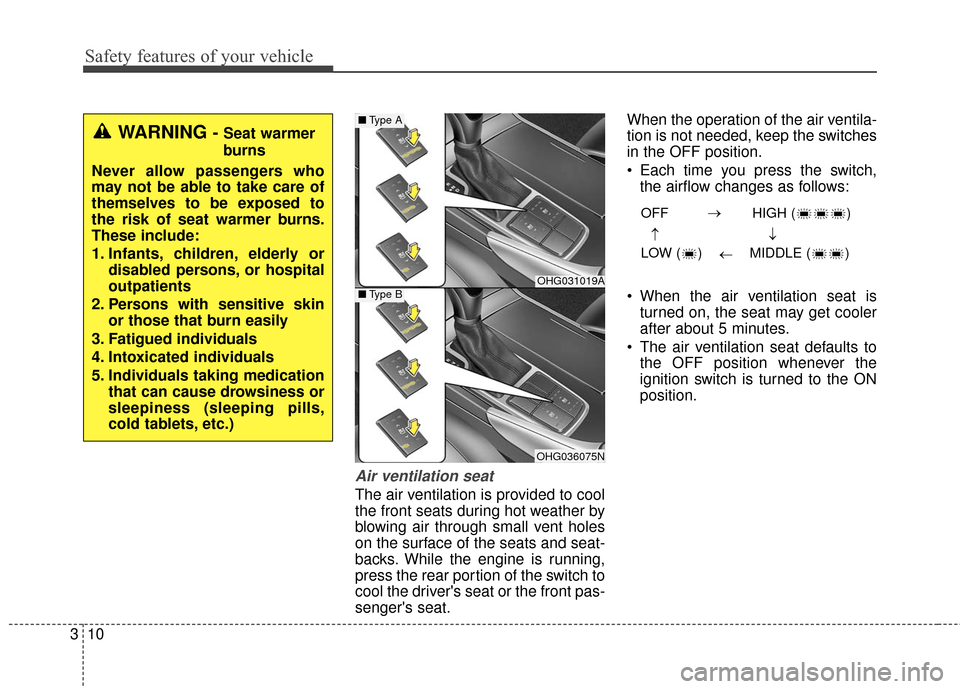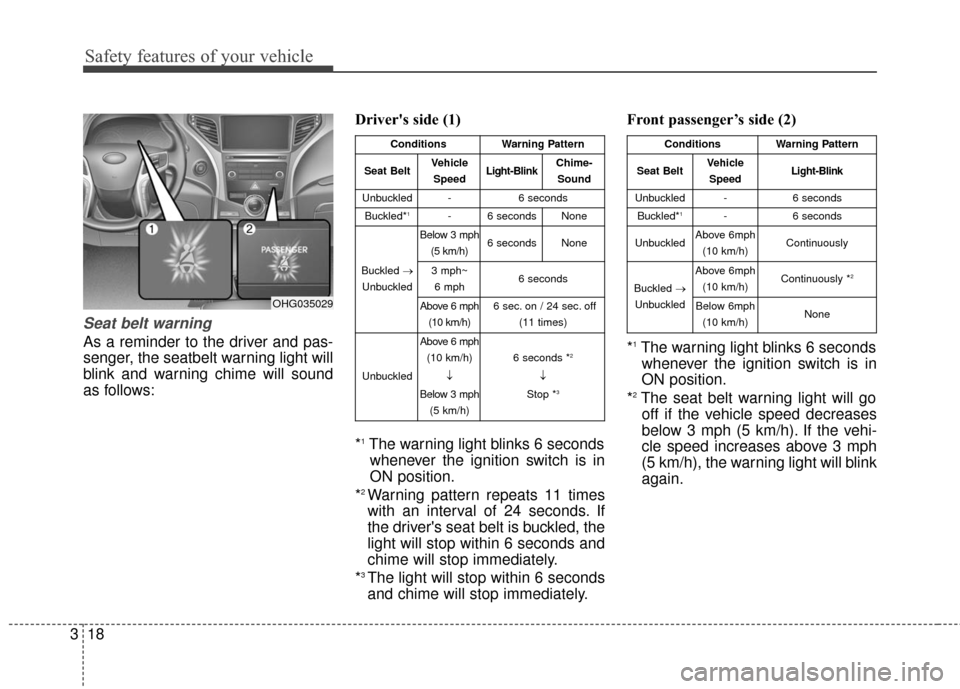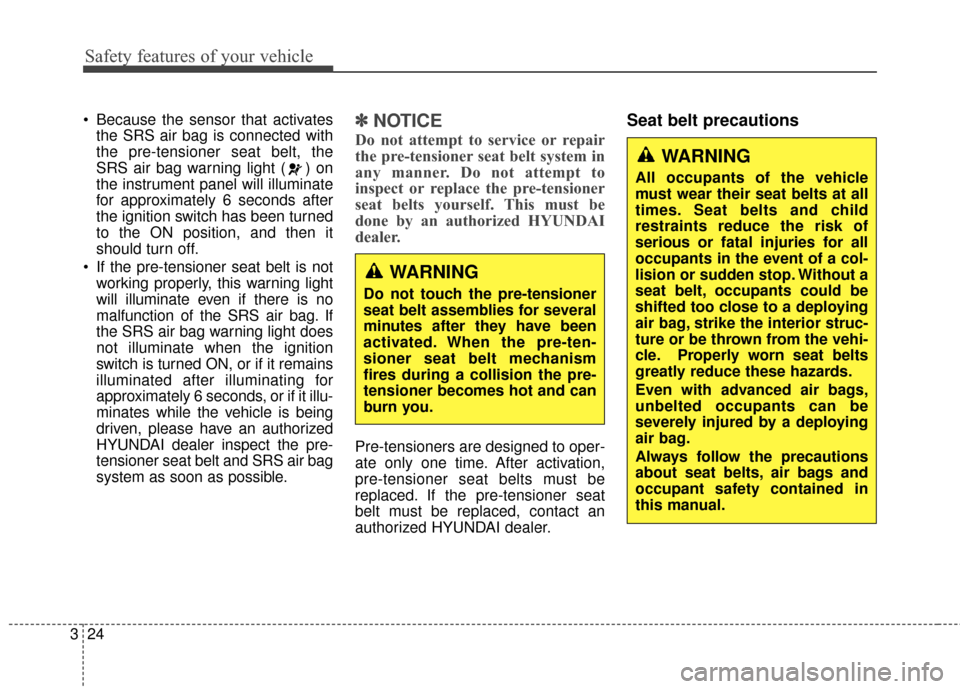2016 Hyundai Azera ignition
[x] Cancel search: ignitionPage 24 of 521

Safety features of your vehicle
43
Front seat
Automatic adjustment
The front seat can be adjusted by
using the control switch located on
the door and outside of the seat
cushion. Before driving, adjust the
seat to the proper position so as to
easily control the steering wheel,
pedals and switches on the instru-
ment panel.
WARNING - Rear
seatbacks
Always lock the rear seatback
before driving. Failure to do so
could result in passengers or
objects being thrown forward
injuring vehicle occupants.
WARNING - Seat
adjustment
Do not adjust the seat while wearing seat belts. Moving the
seat cushion forward may
cause strong pressure on the
abdomen.
Use extreme caution so that hands or other objects are not
caught in the seat mechanisms
while the seat is moving.
Use extreme caution when picking small objects trapped
under the seats or between
the seat and the center con-
sole. Your hands might be cut
or injured by the sharp edges
of the seat mechanism.
WARNING
The power seat is operable with
the ignition OFF.
Therefore, children should
never be left unattended in the
vehicle.
CAUTION
The power seat is driven by an electric motor. Stop the motoroperation once the adjust-ment is completed. Excessiveoperation may damage theelectrical equipment.
When in operation, the power seat consumes a largeamount of electrical power. Toprevent unnecessary chargingsystem drain, do not adjustthe power seat longer thannecessary while the engine isnot running.
Do not operate two or more power seat control switches atthe same time. Doing so mayresult in power seat motor orelectrical component malfunc-tion.
Page 29 of 521

39
Safety features of your vehicle
Seat warmer
The seat warmer is provided to warm
the front seats during cold weather.
With the ignition switch in the ON
position, push either of the switches
to warm the driver's seat or the front
passenger's seat.During mild weather or under condi-
tions where the operation of the seat
warmer is not needed, keep the
switches in the "OFF" position.
Each time you press the button,
the temperature setting of the seat
will change as follows :
The seat warmer defaults to the OFF position whenever the ignition
switch is turned on.
With the seat warmer switch in the ON position, the heating system in
the seat turns off or on automati-
cally depending on the seat tem-
perature.
→
■Type A
■Type BOFF
→ HIGH ( ) → LOW ( )
OFF
HIGH ( )
LOW ( ) MIDDLE ( )
→→→
→
OHG031018A
OHG036074N
■ Type A
■Type B
CAUTION
When cleaning the seats, do
not use an organic solventsuch as paint thinner, ben-zene, alcohol or gasoline.Doing so may damage the sur-face of the heater or seats.
To prevent overheating of the seat warmer, do not place any-thing on the seats that insu-lates against heat, such asblankets, cushions or seatcovers while the seat warmeris in operation.
Do not place heavy or sharp objects on seats equippedwith seat warmers. Damage tothe seat warming componentscould occur.
Page 30 of 521

Safety features of your vehicle
10
3
Air ventilation seat
The air ventilation is provided to cool
the front seats during hot weather by
blowing air through small vent holes
on the surface of the seats and seat-
backs. While the engine is running,
press the rear portion of the switch to
cool the driver's seat or the front pas-
senger's seat. When the operation of the air ventila-
tion is not needed, keep the switches
in the OFF position.
Each time you press the switch,
the airflow changes as follows:
When the air ventilation seat is turned on, the seat may get cooler
after about 5 minutes.
The air ventilation seat defaults to the OFF position whenever the
ignition switch is turned to the ON
position.
WARNING - Seat warmer
burns
Never allow passengers who
may not be able to take care of
themselves to be exposed to
the risk of seat warmer burns.
These include:
1. Infants, children, elderly or disabled persons, or hospital
outpatients
2. Persons with sensitive skin or those that burn easily
3. Fatigued individuals
4. Intoxicated individuals
5. Individuals taking medication that can cause drowsiness or
sleepiness (sleeping pills,
cold tablets, etc.)
OFF HIGH ( )
LOW ( ) MIDDLE ( )
→→→
→
OHG031019A
OHG036075N
■ Type A
■Type B
Page 33 of 521

313
Safety features of your vehicle
Removal and reinstallation
To remove the headrest, raise it asfar as it can go then press the
release button (1) while pulling
upward (2).
To reinstall the headrest, put the headrest poles (3) into the holes
while pressing the release button
(1). Then adjust it to the appropri-
ate height and ensure that it locks
in position.Seat warmer
The seat warmer is provided to warm
the rear seats during cold weather.
With the ignition switch in the ON
position, push either of the switches
to warm the seat.
During mild weather or under condi-
tions where the operation of the seat
warmer is not needed, keep the
switches in the OFF position. Each time you press the button,
the temperature setting of the seat
will change as follows :
The seat warmer defaults to the OFF position whenever the ignition
switch is turned on.
With the seat warmer switch in the ON position, the heating system in
the seat turns off or on automati-
cally depending on the seat tem-
perature.
OFF → HIGH( ) → LOW( )
→
OHG030028OHG030022
Page 38 of 521

Safety features of your vehicle
18
3
Seat belt warning
As a reminder to the driver and pas-
senger, the seatbelt warning light will
blink and warning chime will sound
as follows: Driver's side (1)
*
1The warning light blinks 6 seconds
whenever the ignition switch is in
ON position.
*
2 Warning pattern repeats 11 times
with an interval of 24 seconds. If
the driver's seat belt is buckled, the
light will stop within 6 seconds and
chime will stop immediately.
*
3 The light will stop within 6 seconds
and chime will stop immediately. Front passenger’s side (2)
*
1The warning light blinks 6 seconds
whenever the ignition switch is in
ON position.
*
2The seat belt warning light will go off if the vehicle speed decreases
below 3 mph (5 km/h). If the vehi-
cle speed increases above 3 mph
(5 km/h), the warning light will blink
again.
ConditionsWarning Pattern
Seat BeltVehicle
SpeedLight-BlinkChime-Sound
Unbuckled-6 seconds
Buckled*1-6 secondsNone
Buckled →
Unbuckled
Below 3 mph (5 km/h)6 secondsNone
3 mph~6 mph6 seconds
Above 6 mph (10 km/h)6 sec. on / 24 sec. off (11 times)
Unbuckled
Above 6 mph(10 km/h)
↓
Below 3 mph (5 km/h)
6 seconds *2
↓
Stop *3
ConditionsWarning Pattern
Seat BeltVehicle SpeedLight-Blink
Unbuckled-6 seconds
Buckled*1-6 seconds
UnbuckledAbove 6mph (10 km/h)Continuously
Buckled →
Unbuckled
Above 6mph (10 km/h)Continuously *2
Below 6mph(10 km/h)NoneOHG035029
Page 44 of 521

Safety features of your vehicle
24
3
Because the sensor that activates
the SRS air bag is connected with
the pre-tensioner seat belt, the
SRS air bag warning light ( ) on
the instrument panel will illuminate
for approximately 6 seconds after
the ignition switch has been turned
to the ON position, and then it
should turn off.
If the pre-tensioner seat belt is not working properly, this warning light
will illuminate even if there is no
malfunction of the SRS air bag. If
the SRS air bag warning light does
not illuminate when the ignition
switch is turned ON, or if it remains
illuminated after illuminating for
approximately 6 seconds, or if it illu-
minates while the vehicle is being
driven, please have an authorized
HYUNDAI dealer inspect the pre-
tensioner seat belt and SRS air bag
system as soon as possible.✽ ✽ NOTICE
Do not attempt to service or repair
the pre-tensioner seat belt system in
any manner. Do not attempt to
inspect or replace the pre-tensioner
seat belts yourself. This must be
done by an authorized HYUNDAI
dealer.
Pre-tensioners are designed to oper-
ate only one time. After activation,
pre-tensioner seat belts must be
replaced. If the pre-tensioner seat
belt must be replaced, contact an
authorized HYUNDAI dealer.
Seat belt precautions
WARNING
Do not touch the pre-tensioner
seat belt assemblies for several
minutes after they have been
activated. When the pre-ten-
sioner seat belt mechanism
fires during a collision the pre-
tensioner becomes hot and can
burn you.
WARNING
All occupants of the vehicle
must wear their seat belts at all
times. Seat belts and child
restraints reduce the risk of
serious or fatal injuries for all
occupants in the event of a col-
lision or sudden stop. Without a
seat belt, occupants could be
shifted too close to a deploying
air bag, strike the interior struc-
ture or be thrown from the vehi-
cle. Properly worn seat belts
greatly reduce these hazards.
Even with advanced air bags,
unbelted occupants can be
severely injured by a deploying
air bag.
Always follow the precautions
about seat belts, air bags and
occupant safety contained in
this manual.
Page 57 of 521

337
Safety features of your vehicle
How does the air bag system
operate
Air bags are activated (able toinflate if necessary) only when the
ignition switch is changed to the
ON or START position.
Air bags inflate instantly in the event of a serious frontal or side collision
in order to help protect the occu-
pants from serious physical injury.
There is no single speed at which the air bags will inflate.
Generally, air bags are designed to
inflate based upon the severity of a
collision and its direction. These
two factors determine whether the
sensors produce an electronic
deployment/ inflation signal.
Air bag deployment depends on a number of factors including vehicle
speed, angles of impact and the
density and stiffness of the vehi-
cles or objects which your vehicle
hits in the collision. The determin-
ing factors are not limited to those
mentioned above. The front air bags will completely
inflate and deflate in an instant.
It is virtually impossible for you to
see the air bags inflate during an
accident.
It is much more likely that you will
simply see the deflated air bags
hanging out of their storage com-
partments after the collision.
In addition to inflating in certain side collisions, vehicles equipped with a
rollover sensor, side impact air bags
and curtain air bags will inflate if the
sensing system detects a rollover.
When a rollover is detected, side
impact air bags and curtain air bags
will remain inflated longer to help
provide protection from ejection,
especially when used in conjunction
with the seat belts.
In order to help provide protection in a severe collision, the air bags must
inflate rapidly. The speed of air bag
inflation is a consequence of the
extremely short time in which a col-
lision occurs and the need to inflate
the air bag between the occupant
and the vehicle structures before
the occupant impacts those struc-
tures. This speed of inflation reduces the
risk of serious or life-threatening
injuries in a severe collision and is
thus a necessary part of air bag
design.
However, air bag inflation can also
cause injuries which can include
facial abrasions, bruises and bro-
ken bones because the inflation
speed also causes the air bags to
expand with a great deal of force.
There are even circumstances under which contact with the
steering wheel air bag can cause
fatal injuries, especially if the
occupant is positioned exces-
sively close to the air bag.
WARNING - Air bag
inflation
Sit as far back as possible from
the steering wheel while still
maintaining comfortable control
of your vehicle. A distance of at
least 10" from your chest to the
steering wheel is recommended.
Failure to do so can result in
severe personal injuries or death
caused by a deploying air bag.
Page 58 of 521

Safety features of your vehicle
38
3
Noise and smoke
When the air bags inflate, they make
a loud noise and they leave smoke
and powder in the air inside of the
vehicle. This is normal and is a result
of the ignition of the air bag inflator.
After the air bag inflates, you may
feel substantial discomfort in breath-
ing due to the contact of your chest
with both the seat belt and the air
bag, as well as from breathing the
smoke and powder. Open your
doors and/or windows as soon as
possible after impact in order to
reduce discomfort and prevent
prolonged exposure to the smoke
and powder.
Though the smoke and powder are
non-toxic, they may cause irritation
to the skin (eyes, nose and throat,
etc). If this is the case, wash and
rinse with cold water immediately
and consult a doctor if the symptom
persists.
Never install a child restraint in the front passenger seat.
Never place a rear-facing child
restraint in the front passenger’s
seat. If the air bag deploys, it could
impact the rear-facing child restraint,
causing serious or fatal injury.
In addition, do not place front-facing
child restraints in the front passen-
ger’s seat either. If the front passen-
ger air bag inflates, it could cause
serious or fatal injuries to the child.
1JBH3051
WARNING - Hot
components
Do not touch the air bag storage
area's internal components
immediately after airbag infla-
tion. The air bag related parts in
the steering wheel, instrument
panel and the roof rails above
the front and rear doors are
very hot. Hot components can
result in burn injuries.